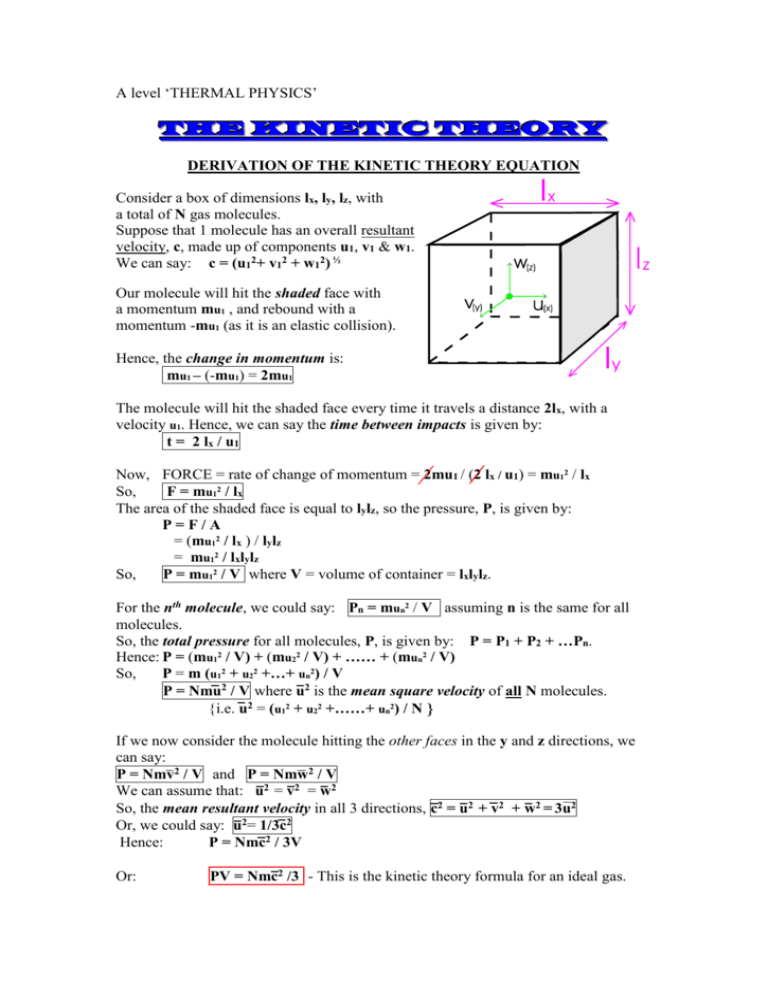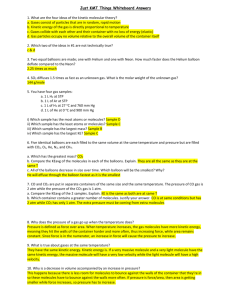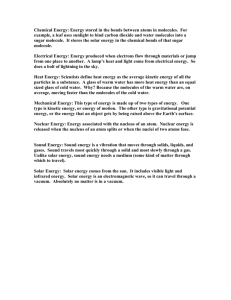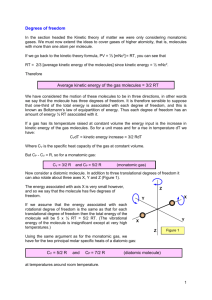A level `THERMAL PHYSICS`
advertisement

A level ‘THERMAL PHYSICS’ T TH HE EK KI IN NE ET TI IC CT TH HE EO OR RY Y DERIVATION OF THE KINETIC THEORY EQUATION Consider a box of dimensions lx, ly, lz, with a total of N gas molecules. Suppose that 1 molecule has an overall resultant velocity, c, made up of components u1, v1 & w1. We can say: c = (u12+ v12 + w12) ½ Our molecule will hit the shaded face with a momentum mu1 , and rebound with a momentum -mu1 (as it is an elastic collision). Hence, the change in momentum is: mu1 – (-mu1) = 2mu1 The molecule will hit the shaded face every time it travels a distance 2lx, with a velocity u1. Hence, we can say the time between impacts is given by: t = 2 lx / u 1 Now, FORCE = rate of change of momentum = 2mu1 / (2 lx / u1) = mu12 / lx So, F = mu12 / lx The area of the shaded face is equal to lylz, so the pressure, P, is given by: P=F/A = (mu12 / lx ) / lylz = mu12 / lxlylz So, P = mu12 / V where V = volume of container = lxlylz. For the nth molecule, we could say: Pn = mun2 / V assuming n is the same for all molecules. So, the total pressure for all molecules, P, is given by: P = P1 + P2 + …Pn. Hence: P = (mu12 / V) + (mu22 / V) + …… + (mun2 / V) So, P = m (u12 + u22 +…+ un2) / V P = Nmu2 / V where u2 is the mean square velocity of all N molecules. i.e. u2 = (u12 + u22 +……+ un2) / N If we now consider the molecule hitting the other faces in the y and z directions, we can say: P = Nmv2 / V and P = Nmw2 / V We can assume that: u2 = v2 = w2 So, the mean resultant velocity in all 3 directions, c2 = u2 + v2 + w2 = 3u2 Or, we could say: u2= 1/3c2 Hence: P = Nmc2 / 3V Or: PV = Nmc2 /3 - This is the kinetic theory formula for an ideal gas. GAS DENSITY: Now, the gas density, = Nm/V, so we could say: P = c2 / 3 NOTE: We could have used any shape of container, although a cube is much simpler. We have calculated the pressure on one side of the container, but the pressure will be the same on all sides of the container. The root mean square (r.m.s.) speed of the molecules is given by: crms = c2 KINETIC ENERGY: If we have N molecules, each of mass, m, and speed, c, then we can say: MEAN TOTAL K.E. = ½ mc2 We can show that: ½ mc2 = 3kT / 2 = 3RT / 2NA Here, k is the Boltzmann Constant (R/NA) which has a value of 1.38 x 10-23 JK-1. When gas molecules collide with each, there may be an exchange of K.E. but the total amount for the gas will remain the same, so there is no increase in the temperature or pressure of the gas. We can see that the TOTAL K.E. is directly proportional to the Temperature (T) for a gas when it is heated. “KINETIC THEORY? Sounds like a load of hot air to me!”










